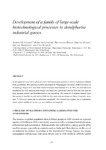Development of a family of large-scale biothechnological processes to desukphurise industrial gases

View/
Use this link to cite
http://hdl.handle.net/2183/12865Collections
Metadata
Show full item recordTitle
Development of a family of large-scale biothechnological processes to desukphurise industrial gasesAuthor(s)
Date
2007Citation
Biotechniques for Air Pollution Control II, 2007: 167-183. ISBN: 978-84-9749-258-4
Abstract
[Abstract] In this paper an overview is given of a new biotechnological process to remove hydrogen sulphide from gas streams. This process is jointly developed by Wageningen University, Delft University of Technology, Paques B.V. and Shell Global Solutions International B.V. In 1992, the first full-scale installation for H2S removal from biogas was taken into operation whilst in 2002 the first unit for high pressure natural gas desulphurisation was started-up. The removal of sulphur dioxide from flue gasses is feasible as well and in 2006 the first unit went on-stream in China. Currently, more than 75 full-scale plants are in operation worldwide. The formed bio-sulphur has a hydrophilic nature which enables its re-use, e.g. as a fertilizer or fungicide.
ISBN
978-84-9749-258-4





